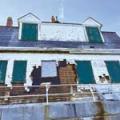Special People, Special Place
photographs by Sarah C. Butler, text by Carl Little
“If I lived in an apartment in New York City, I wouldn’t know a tenth as many people as I know here on this island in Maine. The sea brings in fresh air. You feel that you’re standing on the border between the human world and the rest of the universe.”
–Marguerite Yourcenar
The coast of Maine is made up of thousands of indentations, small and large, where the water impresses the ironbound land, stretching to coves and encompassing rocky necks. Somes Sound, the closest equivalent to a Scandinavian fjord on America’s Atlantic coast, is one of the most dramatic of these channels, reaching to the heart of Mount Desert Island. Sarah Butler was born and raised near the head of this remarkable body of water, in a place she describes as a kind of childhood paradise.
 Exploring her family’s boatyard, Butler came of age among moorings and sails, and Mainers making a coastal living. There, at that village once known as the Town of Sound, she began to orient herself to the world. She found that she lived on an island surrounded by the sea. Her hometown, Northeast Harbor, was situated at the other end of the sound from where she lived. She attended nursery and grade school there, and through her early teens frequented its shops and stores, buying penny candy at McGrath’s or a soda at the Pine Tree Market. Northeast Harbor became central to her life.
Packed off to prep school at age 16—she later attended the Savannah College of Art and Design—Butler felt increasingly distanced from this special place, becoming, for all intents and purposes, a summer person. She drew on this outsider status to embark on the journey that has led to a collection of photographs, a personal portrait of some of the people and places of Mount Desert Island (www.portraitofamaineisland.com) Her work depicts a cross section of residents, a broad blend of social strata, of year-round and seasonal, of livelihoods and ages. She has photographed mechanics, carpenters, lobstermen, shopkeepers, librarians, boatbuilders, and artists. Some of these people are alive and working today; others have passed on.
Butler's photographs have social overtones without being judgmental. The milieus are as important as the figures. The summer people, often dressed in country clothes, relax in the ubiquitous wicker furniture or read the New York Times on the deck, happy in their favorite homes away from home. The “natives” are more often shown on the job, tuning up an outboard motor, showing off a blueberry crop, purveying cloth goods. Dogs are shown as companions to all classes. There are celebrities, too, including Ralph W. Stanley, a humble man who has been declared a national treasure in honor of his boatbuilding skills, and Gunnar Hansen, who played Leatherface in the original "Texas Chainsaw Massacre."
Sarah Butler works with a five-by-seven view camera. Her approach to portraiture has evolved in the years she has pursued her project. Her early photographs reflect the use of guided focus, where the figure emerges out of the background, which is sometimes softened to a blur. The viewer’s eye is directed to the face, the centerpiece of many of her portraits, where we read manifold emotions, from simple pleasure to more complex moods, and study the creases and curves of each singular visage. Seeking greater sharpness and recognizing the importance of the setting, Butler turned later to a more direct style that allows us to see into corners and to the edges of the pictorial space.
In discussing her favorite photographers, Butler mentions Tina Barney and Shelby Lee Adams, both known for their straightforward depictions of people (immediate family and friends in the former’s work, the residents of southern Appalachia in the latter’s). She shares their unfiltered regard for portrait subjects while bringing her own particular perspective to the genre, one that includes myth and emotion. Butler also cites the German photographer August Sander (1876-1964), who once stated, “People are not simply what they are but continually engage in a process of creating and projecting themselves.” That observation is borne out by many of the individuals captured by Butler's lens; they are surrounded by the things that identify them.
Butler's photographs represent a personal journey, with charts and cairns sprinkled throughout the book to help guide the artist and her audience through the special island terrain.
“Mount Desert is not merely an island,” historian Samuel Eliot Morison once wrote, “it is a way of life to which one becomes addicted.”
Sarah Butler’s remarkable photographs capture a community that is fleeting yet real, held together by a shared sense of belonging—and longing. Call it an addiction or call it home—it is a many-layered place inhabited by many-layered people.
Exploring her family’s boatyard, Butler came of age among moorings and sails, and Mainers making a coastal living. There, at that village once known as the Town of Sound, she began to orient herself to the world. She found that she lived on an island surrounded by the sea. Her hometown, Northeast Harbor, was situated at the other end of the sound from where she lived. She attended nursery and grade school there, and through her early teens frequented its shops and stores, buying penny candy at McGrath’s or a soda at the Pine Tree Market. Northeast Harbor became central to her life.
Packed off to prep school at age 16—she later attended the Savannah College of Art and Design—Butler felt increasingly distanced from this special place, becoming, for all intents and purposes, a summer person. She drew on this outsider status to embark on the journey that has led to a collection of photographs, a personal portrait of some of the people and places of Mount Desert Island (www.portraitofamaineisland.com) Her work depicts a cross section of residents, a broad blend of social strata, of year-round and seasonal, of livelihoods and ages. She has photographed mechanics, carpenters, lobstermen, shopkeepers, librarians, boatbuilders, and artists. Some of these people are alive and working today; others have passed on.
Butler's photographs have social overtones without being judgmental. The milieus are as important as the figures. The summer people, often dressed in country clothes, relax in the ubiquitous wicker furniture or read the New York Times on the deck, happy in their favorite homes away from home. The “natives” are more often shown on the job, tuning up an outboard motor, showing off a blueberry crop, purveying cloth goods. Dogs are shown as companions to all classes. There are celebrities, too, including Ralph W. Stanley, a humble man who has been declared a national treasure in honor of his boatbuilding skills, and Gunnar Hansen, who played Leatherface in the original "Texas Chainsaw Massacre."
Sarah Butler works with a five-by-seven view camera. Her approach to portraiture has evolved in the years she has pursued her project. Her early photographs reflect the use of guided focus, where the figure emerges out of the background, which is sometimes softened to a blur. The viewer’s eye is directed to the face, the centerpiece of many of her portraits, where we read manifold emotions, from simple pleasure to more complex moods, and study the creases and curves of each singular visage. Seeking greater sharpness and recognizing the importance of the setting, Butler turned later to a more direct style that allows us to see into corners and to the edges of the pictorial space.
In discussing her favorite photographers, Butler mentions Tina Barney and Shelby Lee Adams, both known for their straightforward depictions of people (immediate family and friends in the former’s work, the residents of southern Appalachia in the latter’s). She shares their unfiltered regard for portrait subjects while bringing her own particular perspective to the genre, one that includes myth and emotion. Butler also cites the German photographer August Sander (1876-1964), who once stated, “People are not simply what they are but continually engage in a process of creating and projecting themselves.” That observation is borne out by many of the individuals captured by Butler's lens; they are surrounded by the things that identify them.
Butler's photographs represent a personal journey, with charts and cairns sprinkled throughout the book to help guide the artist and her audience through the special island terrain.
“Mount Desert is not merely an island,” historian Samuel Eliot Morison once wrote, “it is a way of life to which one becomes addicted.”
Sarah Butler’s remarkable photographs capture a community that is fleeting yet real, held together by a shared sense of belonging—and longing. Call it an addiction or call it home—it is a many-layered place inhabited by many-layered people.

Photographs copyright © 2009 by Sarah C. Butler, from her book, Portraits of a Maine Island, with a foreword copyright © 2009 Carl Little, published by Glitterati Inc.: http://www.GlitteratiIncorporated.com. Available at bookshops and online or through the publisher. Signed copies of the book can be purchased from the photographer, and each image is available as a limited edition of five prints. For more information visit: www.portraitofamaineisland.com
Excerpted by permission.
Carl Little is a regular contributor to Maine Boats, Homes & Harbors magazine and the author of more than a dozen art books. He has written about the work of many photographers, among them, George Daniell, Eve Sonnemann, Nicolas Nixon, Jack Ledbetter, Sharon Arnold, and Arturo Patten. He lives on Mount Desert Island.


















